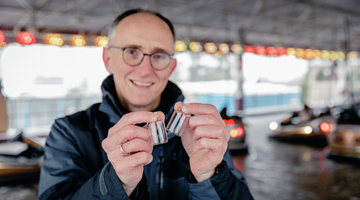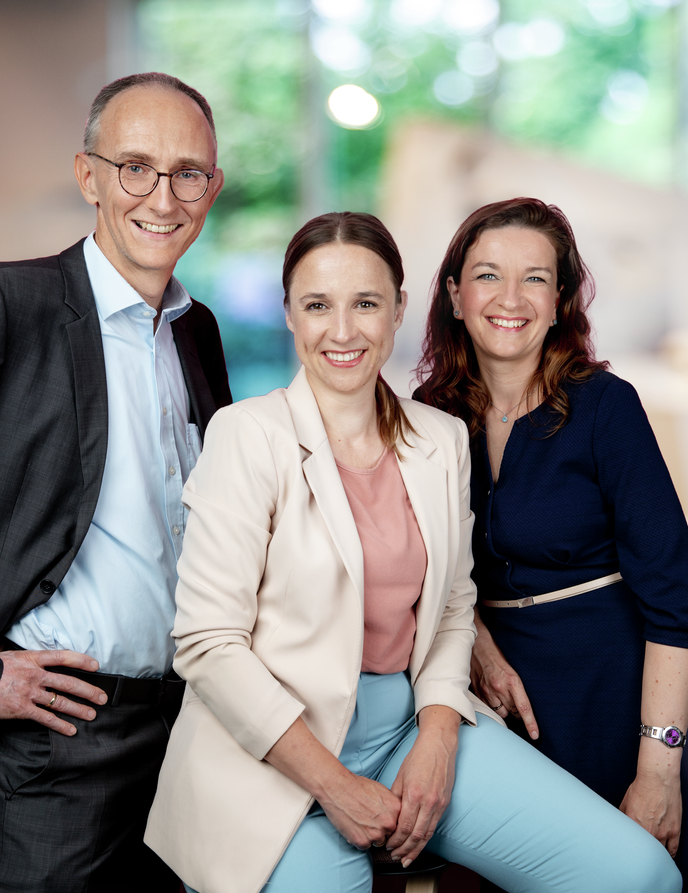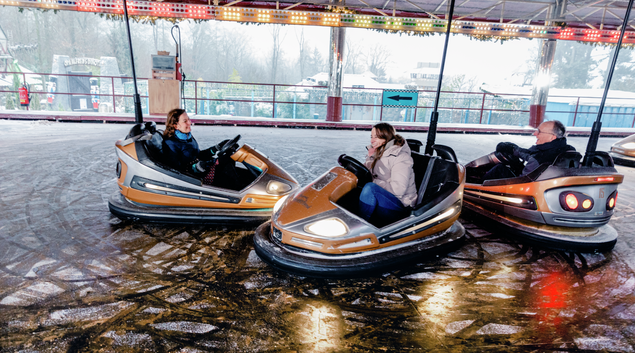
Safe and smooth
What do glass vials for storing medications have in common with a bumper car? Three experts from SCHOTT and SCHOTT Pharma discussed this exciting question when visiting a theme park.
It's snowing and it's cold. The wind whips through the open sides of the bumper car. The colorful lights under the ceiling flash almost surreally in the early morning, while amusement park music hums from the speakers on an endless loop. Despite his clammy hands, Dr. Andreas Langsdorf stays on course. At full throttle, he heads for Diana Löber's vehicle. The rubber rims collide with a dull thud, causing the vehicles to drift apart again. He then turns the steering wheel of the three-wheeled electric vehicle several times at high speed in the other direction. His foot firmly remains on the accelerator pedal. Here, full-throttle means a maximum of 10 km/h. Suddenly, Stephanie Mangold sneaks up from the side and crashes into both vehicles. Everyone laughs. The experiment shows that sitting behind the wheel of a bumper car is fun. And a collision is part of the fun. In the context of pharmaceutical glass vials, which can hold vital medications, however, impacts are more serious. Clashes and damage can occur during production, transport, or filling. But it's not just the trio of physicist, chemist, and product manager who feel well protected by the bumpers – the same applies to millions of vials: just like with bumper cars, the vial's shape combined with a protective layer can ensure safety.
This on-site visit to Taunus Wunderland is unusual. The bumper car at the amusement park just outside Wiesbaden, Germany highlights what optimized glass vials can achieve – action without consequences. "On filling lines, for example, our vials collide with plastic or metal guide rails,” explains Global Product Manager Diana. “Vials can also collide directly with each other.”
Between 400 and 500 vials can whiz across the filling line every minute. The speed and the large quantity in a small space are a major challenge. "They are inevitably pressed against each other again and again, so there is congestion,” says chemist Stephanie. “The speed then develops into forces that the vials have to withstand, because it's not as empty on filling lines as it is on the bumper car ride today."

Andreas drives a bumper car weighing just under 200 kilograms to the edge. It is about two meters long and 1.20 meters wide. At the rear of the vehicle, a three-meter-high antenna touches the power grid stretched across the floor, which feeds the 90-volt motor. Bumper cars have been around in Germany for almost 100 years. Since then, their form, function, and features have hardly changed because they have stood the test of time, but as a team leader in Research & Development, Andreas believes that there's always room for improvement. That's why he grabs a broom and clears the snow from the floor. It's a much better driving experience. Optimization is in the physicist's blood. It is not without reason that he is considered one of the founding fathers of innovative vials for the pharma industry: he began optimizing the small borosilicate glass containers more than three years ago with his characteristic dash of curiosity and innovative spirit. "Vials on the filling line are comparable to a ride in a completely crowded bumper car without any control,” he says. “You're at the mercy of the others. You can't get out of the way." As a result, vials can be damaged, so the scientist's goal is to make glass pharmaceutical containers more robust.
With this in mind, experts from SCHOTT and SCHOTT Pharma took a close look at the vial production over several months and sampled several thousand vials in various batches from all around the world. They used extensive strength analysis as well as simulations to investigate the causes of defects on the glass containers and found significant differences. "This was very exciting for us, because afterwards it was clear that there was potential for improvement," recalls Dr. Andreas Langsdorf. Conducting further analysis, mathematical modeling, and optimization tests in the real production environment, the team aimed to understand these differences and to work systematically in strengthening the stressed areas. They already knew that pre-damaged vials can break at different points, depending on the mechanical load. But one result was unexpected: small changes in the geometry of a vial can already achieve large effects.
Simulation can predict resulting tensile stresses
In the filling line, damage can occur where vials encounter glass-to-glass contact along the body, shoulder, and heel areas or when they hit machine parts. But breakage usually happens only when tensile stresses are added to the defects in the actual loading situation. With the help of computer simulation, the team checked where the pressure on and around the vial body was greatest. They also conducted analysis with Smart Skin drones, which mimic the shape and movement of vials and are equipped with sensors. These proceed through the filling line as data collectors, highlighting critical moments when the containers can develop defects. The team then ended up with a model image of a vial that had been subjected to compressive stress at the top and side. Color gradations were used to visualize the tensile stress created on the glass surface. "These tests continue to be important because they show exactly what happens later at our customers’ sites," says Diana. "We can clearly see the areas with critical tensile stresses."

Thanks to improved geometry, the vials are particularly resistant to impacts and pressures during the filling process.
When it comes to implementing optimization, the complex approval processes and the high quality demands of the pharmaceutical industry provide an additional challenge. "We increased the strength without negatively affecting any of the other complex specifications for such a highly specified pharmaceutical product," says Andreas. "Staying within ISO standards without changing our glass type was extremely important to us." The result is a vial which features a slightly modified geometry within the specified tolerances in the bottom-heel area. However, these minimal changes have achieved big results, because the vials can now withstand significantly higher loads. For example, they can withstand axial pressures four to five times higher than standard vials. That’s why the team settled on the name EVERIC® strong. "Through this development, we’ve ensured that the vials leave our production with outstanding strength," says Andreas. "But of course they also experience quite a journey at the customer's site afterwards. To protect the glass containers in the post-production phase, we have developed a very important additional feature in the form of an outer coating as an ideal complement," adds Stephanie.
Additional protective layer with a good sliding effect
Without music, all that would be heard on the bumper cars would be the whirring of the electric motors, a muffled thud when the rubber bumpers of the vehicles collide, and the laughter of the drivers. Diana Löber still remembers the test run at customer Hoffmann La Roche. It was quiet. Much quieter than usual. The sonorous background clatter of the touching vials was significantly reduced, as if someone had turned down the volume. "It’s running really smoothly," said one of the plant operators to the SCHOTT Pharma product manager. Diana says: "I had to laugh. Up until that point, we had not communicated the product name. But that’s how we knew we had a good instinct." While EVERIC® strong increases the basic strength of the glass, EVERIC® smooth ensures that their ride on the filling line is much smoother.

A transparent outer coating ensures that the vials pass through the production process as smoothly as possible.
Due to the high speed and large quantities on the lines, some vials occasionally become jammed. And with such high pressure in a confined space, sometimes under additionally high temperatures, the vials can stick together and begin climbing upwards. In extreme cases, they can even fall off the line or get scratches and abrasions and have to be discarded. A protective outer coating can significantly reduce this risk. Again, the requirement during development is that the coating has no effect on defined specifications or the glass. "You only feel it when you pick up a vial," Stephanie explains. "Applying the coating has no effect on the inner walls of the vials that come into contact with the drug." Her team tested over 75 coating variations until they found the perfect blend. "It has a very strong bond to the glass and allows for a very nice protective layer with a good sliding effect," says the chemist. With this outer coating, the glass vials have a 56% reduced coefficient of friction.
Tests have shown what is possible with the optimized glass vials and their innovative features. Previously an average of 400 to 500 vials per minute ran over the line, whereas now 750 is possible, reaching the line's maximum capacity. "With well-protected vials, you can process more in the same amount of time," says Stephanie, "That means that production becomes much more efficient." Even if glass strength optimization and the application of an outer coating are more of an evolution from the development step, the result is truly extraordinary. "This modularity is important. Every customer can choose features according to their needs and always find the exact solution they need," Diana says. "We’ve responded to the changing requirements in the pharmaceutical environment and developed an innovation to help store 21st-century pharma drugs safely."
With this modular vial concept, SCHOTT Pharma is ready for the future. The three experts also have a taste for it and announce a return to the amusement park soon – with family, in better weather, and with the anticipation of new experiences. "We'll dare to go faster. Next time, we should definitely bring more people so there's more action on the bumper car ride," says Stephanie. "Because this is just the beginning." That's also true of the advanced pharma glass vials.




